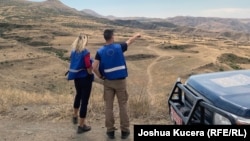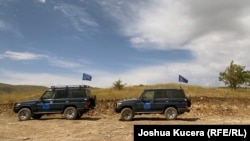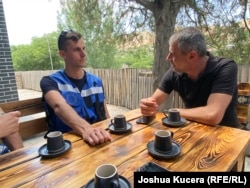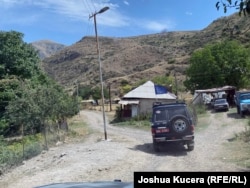JERMUK, Armenia -- Standing on a hilltop above the Armenian resort town of Jermuk, in a blue vest emblazoned with gold EU stars, Thomas Tartarin peered through his binoculars at the verdant mountains across the valley. Then he cross-checked what he saw with a Soviet-era map he was carrying.
“The big peak you see, this is the official border,” he said, gesturing at the most distant visible ridge, about 12 kilometers from the town. That is Azerbaijan, Armenia’s neighbor and archfoe. Not far beyond that ridge lies Nagorno-Karabakh, the territory at the heart of their decades-long conflict.
A year ago, that conflict spilled over here, into Armenia itself, when Azerbaijan launched an offensive across the international border.
Now, on a crest below, a small structure is visible at the end of a dirt road winding down from the peak. These days, Tartarin said, “this is the closest Azerbaijani position.” It was about six kilometers closer, he said.
Last year's offensive saw the heaviest fighting since the Second Karabakh War in 2020 and represented an unprecedentedly large attack by Azerbaijan inside Armenian territory. It also, eventually, led to Tartarin’s arrival here.
Less than a month after the September 2022 fighting and amid fears that the security situation could spiral out of control, the leaders of Armenia, Azerbaijan, and the EU met and agreed on the establishment of an EU civilian monitoring mission. After an initial two-month mission in late 2022, a longer-term EU Mission in Armenia (EUMA) -- this time without Azerbaijan’s buy-in -- was launched in February.
The deployment of even unarmed civilian observers marks an unprecedented Western intervention in a country where Russia has traditionally been the dominant security provider and, despite recent setbacks, still sees itself as the primary power broker. It has also raised Armenian expectations of greater international protection against potential Azerbaijani encroachments and drawn suspicion from Moscow and Baku.
The two-year mission is a modest one, and is being set up on the fly. It currently has fewer than 90 of its planned 103 international staff members. Despite the threat of war hanging over the region, its observers carry no weapons. It is still headquartered at Yerevan’s Marriott Hotel while its facility in the southern Armenian city of Yeghegnadzor is being completed. The mission has opened four of an eventual six forward operating bases from which monitors will patrol along the border.
In mid-August, RFE/RL joined one of the several daily patrols that the mission is already carrying out.
It was conducted by Tartarin, a French gendarme with a military comportment and wraparound shades who heads the mission’s forward operating base in Jermuk. He was accompanied by Pekka Mattila, a jocular Finn in aviator sunglasses who is a veteran of several international missions, including a similar EU monitoring effort in neighboring Georgia.
This was the first stop, for what the monitors call a security situation awareness patrol. The monitors (along with this reporter and a press officer) drove up the rough road in two Toyota Land Cruisers, small EU flags fluttering from the back of the vehicles.
For patrols like this one, relatively far from the line of contact between Azerbaijani and Armenian forces, the monitors go unaccompanied and without body armor. For visits closer to the line, they are escorted by Armenian soldiers and they announce their itinerary ahead of time to Azerbaijani military officials.
On this day, there was no visible activity in the new Azerbaijani positions. Tartarin’s map had their locations marked in orange dots, forming an arc well inside the dotted line representing the then-border between the Armenian and Azerbaijan Soviet socialist republics.
'Really Severe Incidents Decreased'
Since the September offensive there has been no further advance toward Jermuk, but Azerbaijani troops have been gradually reinforcing their positions with new roads and barracks, Tartarin said.
Checking on construction and reinforcements is all the monitors are capable of doing, given their modest numbers and the extent of the roughly 1,000-kilometer border. This has led to some disgruntlement among Armenians hoping that the mission would help point the finger at Azerbaijani troops as the source of sporadic shooting incidents along the border and call out Baku for such escalations.
“At the beginning, it was hard for people to understand because if there was an incident then they expected me to show up in the news in the evening, making a statement about what happened and who was guilty,” Markus Ritter, the head of the mission, told RFE/RL at EUMA's Marriott headquarters. “But that is not our job, that is not our mandate, and we are not able to do that.”
Nevertheless, the monitors’ presence has tamped down violence along the border, Ritter argued.
“Since our arrival here we still have incidents, but the kind of incidents changed: We have no killed or wounded civilians since we are here, and the number of really severe incidents decreased. So I think this is also our contribution to relax, to calm down, the tensions here in the area,” he said.
Baku and Yerevan have been locked in a dispute over Nagorno-Karabakh for decades. Armenian-backed separatists seized the mainly Armenian-populated region from Azerbaijan during a war in the early 1990s that killed some 30,000 people. Diplomatic efforts to settle the conflict brought little progress, and the two sides fought another war in 2020 that lasted six weeks before a Russian-brokered cease-fire effectively recognized the loss of Armenian control over parts of the region and seven adjacent districts.
In 2022, Baku and Yerevan embarked on negotiations aimed at finally resolving the conflict. The European Union has played the lead role in that process, with European Council President Charles Michel holding regular meetings between Armenian Prime Minister Nikol Pashinian and Azerbaijan President Ilham Aliyev.
But even as the diplomatic negotiations have continued, tensions on the ground have risen. In Karabakh itself -- outside the EUMA mandate -- the Azerbaijani government has instituted a monthslong de facto blockade. The situation along the Armenia-Azerbaijan international border is less volatile, but occasional violent incidents and irredentist rhetoric from Baku about Armenian territory have strained the nerves of residents here.
After the patrol in mid-August, the monitors got back into their Land Cruisers and headed back to Jermuk, where following last year’s attacks -- in which the town itself was shelled — tourists have returned in pursuit of its fresh air and mineral-water cures. The patrol then headed down the serpentine road to the main highway and into the stark, rocky landscape toward Azerbaijan’s exclave of Naxcivan.
'You Are Not Doing Enough'
They stopped at the village of Zaritag, about an hour’s drive to the southwest, nearer to the second of Armenia's borders here in Vayats Dzor Province. This was the second type of mission they conduct, known as a human security patrol, in which monitors carry out informal surveys of residents of border areas to find out how they feel about the security situation. EUMA was still in the process of hiring Armenian staff to accompany them and translate, so each human security patrol took along at least one Russian speaker. This time, it was Mattila, who took the lead.
'“Will it escalate, re-escalate? Will the war start again?'" he described of his method. "And then if they say yes, 'Why?' How do they feel about the Russian peacekeeper presence [in neighboring Nagorno-Karabakh]?” They also ask residents about the EU presence, he said. “Very often they say [good things] -- they are very hospitable, like in Georgia, but then if you ask more, then they can say, 'You are not doing enough.'"
In Zaritap, the monitors found Magak Hovannisian, the voluble proprietor of a combination coffee and barber shop in the village center. He prepared coffee for the group and sat down to discuss how people were faring.
“Of course, it’s normal to be afraid,” Hovannisian said. “But people are used to it. If a bomb falls over there, people will just wonder where the second one will fall.”
The EU mission has arrived with Armenians’ trust in their traditional security guarantor, Russia, at a nadir.
“The international community needs to resolve this issue,” Hovannisian said. “If Armenians and Azerbaijanis are left alone, we will just be fighting all the time.” Asked whether people thought it should be Russia, the European Union, the United States, or another power who should take the lead, he demurred. “The important thing is for them to be strong,” he said.
Russian peacekeepers in Nagorno-Karabakh have been perceived as impotent in the face of regular Azerbaijani pressure and advances, and Armenians have questioned the usefulness of the Russia-led Collective Security Treaty Organization, which failed to respond to Azerbaijan’s incursions inside Armenian territory.
'Unrealistic Expectation'
The EU presence is tiny compared to the thousands of Russian troops who guard Armenia's borders with Turkey and Iran, in addition to those stationed at a Russian military base in the northern city of Gyumri or as peacekeepers in Nagorno-Karabakh.
But the novelty of the European presence initially led to outsized expectations.
“At the beginning, I think for the population it was not really clear what was our mandate,” Ritter said of the EUMA mission. “We also found this out when we were visiting the villages in the conflict-affected areas. A lot of them thought we are now here to protect them or we even will somehow replace the Russian peacekeepers.”
Richard Giragosian, the head of the Yerevan think tank Regional Studies Center, said that "seeing the EU monitors and the EU flag was equated as a replacement of the Russian security promise, which is both unfounded and also not realistic."
“So," he said, "the danger for the Armenian side is this unrealistic expectation.”
At the same time, the mission’s arrival has occasioned anger in Russia. "The EU is openly abusing its relations with Armenia and Azerbaijan, including by pushing its ‘mission’ into Armenian territory, raising serious questions about its legitimacy," Russian Foreign Minister Sergei Lavrov told a news conference in Baku with Azerbaijani counterpart Jeyhun Bayramov days after the mission was launched.
Giragosian, however, dismissed those as pro forma complaints: “They have to say that.” Unarmed EU observers are relatively unthreatening to Moscow, as far as Western interventions go, he said. The EU mission even indirectly shores up the Russian presence in Armenia, he said, insofar as it bolsters security that makes Russia’s priorities, such as establishing new cross-border transportation routes in the region, more feasible.
Azerbaijan, for its part, has regularly complained about the monitors. It acceded to last year’s short-term mission in the belief that it would help reach a peace deal by the end of the year. But when the negotiations got bogged down, Baku blamed the mission, according to Azerbaijani analysts.
Baku now argues that Armenia is using EU cover to drag its feet on the diplomatic process. “We see that since the beginning of the mission, the Armenian position in the negotiating process has become more destructive,” Bayramov said alongside Lavrov.
Baku has been using “coercive diplomacy" and the September 2022 offensive to pressure Armenia at the bargaining table, said Shujaat Ahmadzada, a research fellow at the Baku-based Topchubashov Center, which focuses on international relations and security. It therefore sees the EU presence on the border as “affording Yerevan increased flexibility in negotiations, eroding the effectiveness of measures that had previously limited Armenia's options in resisting an agreement with Azerbaijan,” he said.
The difficulty of balancing the two sides’ diverging expectations was illustrated in an August 15 episode in which the Armenian Defense Ministry tweeted out a claim that Azerbaijani troops had “targeted” the EU monitors in a joint patrol with Armenian soldiers. The EU mission quickly tweeted a denial, with the word “FALSE” stamped over the Armenian post. That, in turn, was enthusiastically picked up by Azerbaijani social media users before the EU team deleted it and issued a gentler denial saying the team had “been present to the shooting incident.”
A press officer for the EU mission, Ema Stastna, said later that the shooting took place about a kilometer from the EU monitors. “It was not possible to determine the target of the shots, but the EUMA patrol did not feel targeted,” she said, adding that monitors are occasionally witness to shooting in the distance.
Ritter denied that the monitors had been targeted: “We have never been threatened so far,” he said.
For Armenia, the EU monitors amount to “hostages to Armenian security -- literally, think of a bank robber taking hostages,” Giragosian said. In a worst-case scenario, if a monitor is harmed, even accidentally, “that will not only prompt an EU institutional response but, more importantly, it will drive EU member states” to respond more forcefully, he said.
After the conversation and coffee in Zaritap, it was nearly time to head back to the Jermuk base, where the team would write up reports for Brussels. But first, they had to make one more stop, in the village of Gomk, a bit farther down the road from Zaritap.
The village was mostly empty aside from a small team of visiting construction workers building a new school. Mattila handed out leaflets explaining what the mission does, in both English and Armenian, and gently parried the men's requests for EU visas.
Finally, the team stopped briefly to talk to an elderly resident standing by her front gate. They politely declined when the woman, Lyuba Karapetian, invited the observers in for coffee. But there was time for Mattila to ask her how people in Gomk feel about their security. “For now, it’s OK,” she said. “In the future, who knows?”





